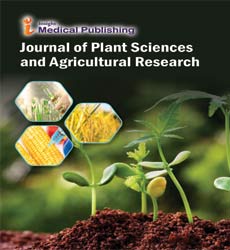Low-Carbon Agricultural Technologies in Mitigating Environmental Impacts
Xia Claros*
Department of Agriculture and Life Sciences, Lincoln University, Christchurch, New Zealand
- *Corresponding Author:
- Xia Claros
Department of Agriculture and Life Sciences, Lincoln University, Christchurch,
New Zealand,
E-mail: claros.x@gmail.com
Received date: November 29, 2024, Manuscript No. IPJPSAR-24-20188; Editor assigned date: December 02, 2024, PreQC No. IPJPSAR-24-20188 (PQ); Reviewed date: December 16, 2024, QC No. IPJPSAR-24-20188; Revised date: December 23, 2024, Manuscript No. IPJPSAR-24-20188 (R); Published date: December 30, 2024, DOI: 10.36648/ipjpsar.8.4.167
Citation: Claros X (2024) Low-Carbon Agricultural Technologies in Mitigating Environmental Impacts. J Plant Sci Agri Res Vol.8 No.4: 167.
Description
Agriculture is one of the key sectors contributing to Global Greenhouse Gas (GHG) emissions, which significantly impact climate change. According to the Food and Agriculture Organization (FAO), agriculture accounts for around 25% of global GHG emissions, primarily from the use of fertilizers, animal husbandry, soil management and energy consumption in farming activities. As the world faces the urgent need to reduce carbon emissions to mitigate climate change, the agricultural sector must embrace low-carbon technologies to minimize its environmental footprint. Low-carbon agricultural technologies aim to reduce the carbon intensity of farming operations, enhance carbon sequestration in soils and promote the efficient use of resources. These technologies are critical in ensuring sustainable food production while addressing the environmental challenges associated with climate change.
Reducing carbon emissions
Precision farming or precision agriculture, involves using advanced technologies such as GPS, remote sensing and data analytics to optimize the use of resources in farming. By applying inputs (like water, fertilizers, pesticides and seeds) more efficiently, precision farming minimizes waste, reduces the environmental impact of agriculture and increases productivity. This technology plays a significant role in reducing carbon emissions by optimizing energy use and minimizing input wastage. One of the key elements of precision farming is Variable Rate Technology (VRT), which allows farmers to apply fertilizers, pesticides and irrigation based on the specific needs of different areas within a field. This technology uses real-time data collected from sensors, drones or satellites to analyze the variations in soil composition, moisture levels and pest populations across a farm. By ensuring that inputs are only applied where they are needed, VRT reduces the overuse of fertilizers and pesticides, both of which contribute to greenhouse gas emissions through nitrogen oxide release and the energy-intensive production of these chemicals.
Furthermore, precision farming improves the efficiency of irrigation practices, which is need for reducing water consumption and energy use. Traditional irrigation methods often result in water wastage and the overuse of energy for pumping and distribution. In contrast, smart irrigation systems equipped with sensors and weather forecasting technology can optimize water use, ensuring that crops receive only the necessary amount of water at the right time. This helps conserve water resources, reduces energy consumption and lowers the carbon footprint associated with irrigation practices. Another important low-carbon agricultural technology is no-till farming, a practice that involves growing crops without disturbing the soil through plowing or tilling. Traditional tilling practices release significant amounts of carbon dioxide into the atmosphere by disturbing the soil and exposing stored carbon to oxidation. In contrast, no-till farming helps sequester carbon in the soil, reducing the amount of greenhouse gases released into the atmosphere. No-till farming works by leaving crop residues on the soil surface, which acts as a protective mulch, preventing soil erosion, improving soil structure and increasing water retention. Over time, the organic matter in the residue decomposes and enriches the soil, promoting the growth of beneficial soil microbes that contribute to nutrient cycling and overall soil health. This not only helps reduce the need for synthetic fertilizers but also creates an environment that supports more sustainable crop production. The practice of no-till farming has been shown to reduce the carbon footprint of agricultural operations significantly.
Agroforestry and renewable energy integration
Agroforestry is another low-carbon agricultural practice that combines trees with crops or livestock in a synergistic manner to benefit both the environment and farm productivity. Trees help sequester carbon, reduce soil erosion, increase biodiversity and enhance water retention, all while providing additional income streams from timber, fruits or nuts. Integrating agroforestry into farming systems can significantly reduce the carbon emissions associated with conventional agriculture. Agroforestry systems can be designed in various ways, such as planting trees in rows between crops (alley cropping), establishing windbreaks to reduce wind erosion or creating forest patches alongside agricultural fields. The trees in these systems capture carbon dioxide through photosynthesis, storing carbon in their biomass and the soil. Additionally, the shade provided by trees can reduce evaporation, improve microclimates for crops and protect against extreme weather conditions. Incorporating renewable energy sources into agricultural operations is another effective way to reduce the carbon footprint of farming. The use of solar panels, wind turbines and biogas systems in agricultural operations can significantly cut down on the reliance on fossil fuels. Solar energy, for example, can power irrigation systems, greenhouse heating and other farm equipment, reducing the need for diesel or electricity generated from coal. Biogas systems that convert organic waste into energy can also provide a sustainable solution for waste management while generating electricity or heat for use on the farm.
Open Access Journals
- Aquaculture & Veterinary Science
- Chemistry & Chemical Sciences
- Clinical Sciences
- Engineering
- General Science
- Genetics & Molecular Biology
- Health Care & Nursing
- Immunology & Microbiology
- Materials Science
- Mathematics & Physics
- Medical Sciences
- Neurology & Psychiatry
- Oncology & Cancer Science
- Pharmaceutical Sciences
